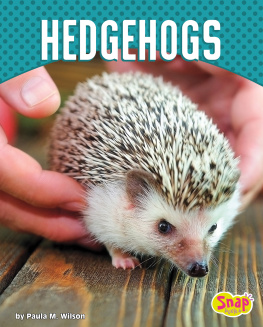Hedgehogs
By: Alice Joe
Copyright 2015 by Alice Joe
A ll rights reserved. No part of this book may be used or reproduced in any manner whatsoever without the express written permission of the publisher except for the use of brief quotations in a book review.Image Credits: Royalty free images reproduced under license from various stock image repositories. Under a creative commons licenses.
Hedgehog

T he hedgehog is a spiky mammal known for its cuteness and helpfulness in getting rid of pests. It gets its name because of the way it finds food; it digs through hedges to find small insects, frogs, mice, and even snakes, all while making pig-like grunts and noises.
What they look like

H edgehogs have about 5,000 spines that act as armors against anything that attack them. Their stomachs are unprotected, so if theyre attacked, they curl up into a ball of spine to cover the stomach while pricking anyone who tries to attack it. Each of these spines lasts for about a year, after which they fall out so that new ones could take its place. Hedgehogs are used to moving and foraging at night, so to compensate for their weak eyesight, they use their strengthened nose and ears to explore the hedges and find food.
What they eat

H edgehogs usually eat small creatures like rats, centipedes, mice, and other creatures they find while poking their noses around hedges. Gardeners love them because they are very good in hunting pests that destroy plants. They also eat foods meant for dogs and cats.
Where they live

T here are different species of hedgehogs scattered throughout Africa, Asia, and Europe. European hedgehogs eat as much as they can when its autumn so that by October, they could get their nests made of leaves ready for hibernation throughout winter. Hedgehogs in hot places do something similar to hibernation: aestivation. This means that they sleep when its too hot and find food when its not too hot anymore.
Social life

H edgehogs usually either live alone or in pairs; they dont like living in groups. Even hedgehogs that choose to pair up only do so because they want to mate. After mating, they separate again. Hedgehogs are known to be solitary and therefore dont enjoy making friends with other hedgehogs.
Mating

W hen a male hedgehog wants to mate with a female hedgehog, he circles around her, sometimes for a very long time until she agrees to mate. When they do, they make loud piggy noises. After that, they separate again, leaving the mother to take care of the babies until they can take care of themselves.
Babies

W hen a hedgehog gives birth, 1-11 babies could come out. The mother takes care of the babies for about one month to a little less than two months. While the babies are still weak and vulnerable, the mother guards them from other male hedgehogs that sometimes prey on other baby hedgehogs. The mother might eat her babies if she finds out that the nest is disturbed, but sometimes she just moves them to a new nest.
Behavior

H edgehogs are often easy to find in the city because they are attracted to food. They like to go inside small spaces to find small creatures that they could eat. Youre most likely going to find them in action at night, but not when its too cold or too hot.
Habitat

H edgehogs are usually found in meadows, hedgerows, and woodlands, where there are plenty of small animals for them to find and eat. In some gardens, however, people have reported seeing hedgehogs helping to get rid of mice and other pests. They usually have nests they like to sleep in during the day.
Predators

B adgers are the usual predators of Hedgehogs, especially in Europe. They are strong enough to break through the hedgehogs armor of spine, which is why they tend to avoid places where there are many badgers. For younger hedgehogs that dont have very strong spines, any animal with sharp teeth like dogs, could kill them.
Sense

S ince hedgehogs usually hunt at night, they dont really need good eyesight. However, since they usually poke through small, dark spaces, they have developed a very strong sense of hearing and smelling so they could find their prey easily.
Health

H edgehogs are known to have fleas that stay with them throughout their entire lifetime, but they can only survive on hedgehogs and not other animals or people. These fleas are also not harmful since there are not enough of them to weaken hedgehogs. Ticks are also quite common and are also not harmful if there arent too many of them, but if a hedgehog is sick, more ticks may latch on to it and weaken it further. Internal parasites like lungworms are usually the most dangerous since they can kill the hedgehog if left untreated.
Lifespan

L arge species of hedgehogs usually live for about 4-7 years, while small species usually live for about 2-4 years. Hedgehogs can live twice their normal lifespan when cared for as a pet because they are safe from predators, and also have better food.
Hedgehogs as pets

A lot of people in European countries now keep hedgehogs as pets, except for the wild ones, which are endangered. In some US states, however, keeping hedgehogs as pets is illegal. Domesticated hedgehogs could eat cat food, with the addition of treats like small insects and vegetables. Being very clean animals, they dont really need to be groomed except for their nails, but periodic baths can help them stay clean. Pet hedgehogs should be kept in large cages where they could explore and run around in.























